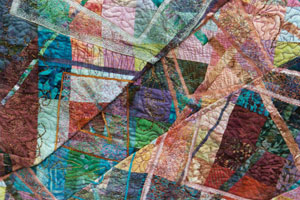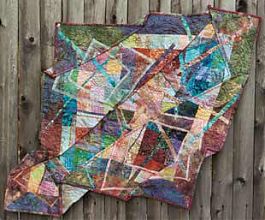Craft to Heal: Soothing Your Soul with Sewing, Painting, and Other Pastimes
Read the first chapter below:
The Surprising Connection Between Crafts, Creativity, and Healing
“Some of us feel bad about [taking] time for creative expression. One would think that we’d view creativity as ‘more productive’ and hence less guilt-producing than leisure, yet we still seem to believe that self-expression is less of a priority than satisfying the needs of others.”
Alice Domar, Ph.D., Self-Nurture
Time heals all wounds. But until time kicks in, what do you do while you’re waiting? How do you relieve stress and decompress from everyday pressures? How do you ease the pain, distract your mind, soothe your soul? If you’re like me—and I suspect you are—you craft.
I’ve been a crafter for as long as I can remember. I quilt. I sew. I collage. I paint. I make wreaths. I design note cards. I love to create something out of nothing and put my personal stamp on it. I love the process, and I love the product. The creative arts, my crafts, keep my hands, heart, and mind busy, and sometimes I think they’re the only things that keep me sane. And I’m not alone. Far from it. In fact, from the time that man began recording time, the creative arts have been used as unique forms of expression, communication, and release. Just think of the stick figures found on the cave walls of our earliest ancestors, the decorative vases molded by ancient Chinese cultures, or the ornate tombs of the early Egyptians. Now, in the twenty-first century, these arts have been elevated from mere crafts to important components of healing therapies for people with illnesses, both physical and psychological. Patients with cancer, for instance, are encouraged to paint, to visualize their bodies fighting off malignant cells, and to pour their thoughts and emotions into journals. Likewise, abused children are asked to draw pictures to help therapists gain access to their feelings and fears. Arts and crafts are even used as part of the therapeutic rehabilitation of the disabled, the mentally disadvantaged, and those with substance abuse problems, and to engage the elderly.
But the best news is that you don’t have to be ill to benefit. “We’re now finding that crafts are beneficial for healthy people, too,” says Gail McMeekin, M.S.W., a career coach in West Roxbury, Massachusetts, and the author of the inspiring books The 12 Secrets of Highly Creative Women and The Power of Positive Choices. “Thanks to their ability to tune you into yourself and your feelings, crafts clearly have physical, psychological, and spiritual powers.” Adds Diane Ericson, a California fabric artist, teacher, and pattern designer, “Crafts are a way of valuing yourself and giving to yourself. They allow you to express what’s inside.”
America’s Most Popular Pastimes
- Cross-stitch/embroidery
- Crocheting
- Apparel/fashion sewing
- Home décor painting/accessories
- Craft sewing
- Cake decorating/cake making
- Needlepoint/plastic canvas
- Art/drawing
- Floral arranging
- Home décor sewing
- Scrapbooking/memory crafts
Source: Hobby Industry Association
The Study of Crafting
Crafting is a multibillion-dollar business in America, and over three-quarters of American households have at least one family member who spends an average of 7.5 hours weekly engaged in crafting or hobbies. But despite crafting’s popularity, researchers haven’t spent much time exploring its benefits.
| The Stats on Crafts | |
|---|---|
| Number of households that participate in crafts | 76% |
| Average number of crafts/hobbies engaged in per household | 4.7 |
| Average number of hours spent on a craft or hobby | 7.5 hours per week |
| Most popular craft | Cross-stitch/embroidery |
| Most popular craft group activity | Scrapbooking/memory crafts |
| Average amount spent on a craft | $1,230 a year |
| What people do with their crafts | Give them away, decorate their homes, or use themselves |
Sources: Various surveys conducted by the Hobby Industry Association
Luckily, there is one landmark study—one that was deemed important enough to be mentioned in the prestigious Journal of the American Medical Association. In the study, which was sponsored by the Home Sewing Association, researchers took 30 women (15 experienced sewers and 15 novice sewers) and measured their blood pressure, heart rate, perspiration rate, and skin temperature—all gauges of stress—via biofeedback before and after they performed five leisure activities that required similar eye-hand movements. The pastimes included sewing a simple project, playing a card game, painting at an easel, playing a hand-held video game, and reading a newspaper. The results showed that sewing was the most relaxing activity of the five studied: It produced drops in heart rate, blood pressure, and perspiration. In contrast, stress measures increased after the women performed the other tasks, especially after playing a card or video game.
According to Robert Reiner, Ph.D., a New York University psychologist and the study’s author, the findings prove what crafters already know: Crafts de-stress. “The act of performing a craft is incompatible with worry, anger, obsession, and anxiety,” he says. “Crafts make you concentrate and focus on the here and now and distract you from everyday pressures and problems. They’re stress-busters in the same way that meditation, deep breathing, visual imagery, and watching fish are.”
Harvard University’s world-renowned mind/body expert, Herbert Benson, M.D., says that repetitive and rhythmic crafts such as knitting may even evoke what he calls the relaxation response—a feeling of bodily and mental calm that’s been scientifically proven to enhance health and reduce the risk of heart disease, anxiety, and depression. “You can induce the relaxation response through any type of repetition, whether it’s repeating a word, prayer, or action, such as knitting or sewing,” he notes. “The act of doing a task over and over again breaks the train of everyday thought, and that’s what releases stress.”
Unfortunately, many of us push crafting and creativity to the bottom of our To Do list. Maybe we feel guilty for doing something for ourselves—women, of course, are taught that everyone else’s needs should come first—or maybe we feel that even when we’re relaxing, we should be doing something productive (that old multitasking thing). But now that research is showing the creative arts are good for our health and relationships, we no longer need to view leisure pursuits as self-indulgences. We can recast them in a new light: Crafts aren’t just enjoyable, they’re downright therapeutic.
Letting in the Power of Crafts
In interviewing creative women for her first book, Gail McMeekin learned that there are no mistakes in creating, only lessons. “Many inventions are the result of so-called errors,” she says. “When you suspend judgment about what is and what isn’t a mistake, you open your mind to creating extraordinary things and to receiving extraordinary things too. You let in the healing power of crafts.”
I’ve experienced this power first hand on many occasions, but especially when I began making a quilt that I ended up calling “My Divorce Quilt” in the summer of 2000. I was taking a workshop that explored the use of decorative threads on quilt tops. I don’t know why—perhaps because the technique of embellishing was so new to me—but I decided to give myself permission to make up the quilt as I went along. I had no real plan, which is not the way I usually work at all. Most of my quilts follow a pattern and are somewhat uniform and regimented, and I’m hounded by a desire for perfection. But this time, I didn’t try to make all of the elements work together. I just did what I wanted, spontaneously sewing this way and that according to whim, ignoring the usual conventions and restraints, and letting errors become planned eccentricities instead.
First, I pieced together 200 small batik squares into a larger square shape. Then I applied the thread, creating, over hours and days, geometric shapes across the quilt top. Next, I highlighted the shapes with variegated yarns. Finally, I began to machine quilt in a most verboten way: putting flowers and curly-cues next to squares, triangles, and other angular shapes. I even used whatever color thread I picked up first, without caring if it matched the fabric or not.
I was bold and in the process, I was unconcerned about the end result and often put aside the quilt to look at it and search for inspiration while I worked on other pieces. This, too, was unusual for me, since I typically rush to finish one project and start another on my ever-expanding list of quilts I want to make. I was moving beyond the constraints of doing things “the right way,” which I applied to my life and my quilting, to just seeing where the project would take me. Suddenly, screwing up was just a way of discovering something new.
As I worked on the quilt over several weeks, I began to see that the evolving design was expressing some of the chaos and confusion I was feeling as I went through my divorce. And as I neared the end of the project, I was overwhelmed (or perhaps underwhelmed) by the finished product. The quilt was a busy and disheartening mishmash. I entertained the idea of slicing it up and repiecing it. Unable to bring myself to actually cut into a piece I’d spent so many hours sewing, I was inspired instead to fold it several times on the diagonal and tack it down. And I loved the way it looked—it now has a kind of mangled, arrow shape to it, which is entirely appropriate to its purpose. It looks like it has been through an antique washing machine—just as I felt I, as a human being, had been—so I renamed it “My Divorce Quilt: Through the Wringer.”
My Divorce Quilt: Through the Wringer
Of all of my quilts—and I’ve made over 100—this one has elicited the biggest and most dramatic response from people who view it. When I hung it in my guild’s quilt show, it created a buzz among the attendees. One woman told me that she thought the folds were my way of trying to tuck away memories of my marriage. She even suggested that I might feel compelled to fold it further as time passed, signifying my healing from the divorce and my moving on to a new life. I was fascinated by this insight, and suddenly realized that I had created my first art quilt! Whatever I had made—and it certainly wasn’t a typical quilt or even one that I particularly liked—expressed something deep inside of me. And this quilt definitely says something, not only to me, but also to others. Making it and showing it has helped me to heal the chasm in my life and to feel whole again, this time as a single person. And it turned out to be a message to myself that it was time for me to pursue life without a strict adherence to a plan. Since that time, I’ve opened up creatively and emotionally to exploring life in general as more of a process, and enjoying the twists and turns, rather than just rushing to the goal.
That is the gift of crafts. They can transport us to another place and help us in our journey through life. They can heal our souls, if we allow them to. All we need is permission from ourselves to spend time creating and the courage to push beyond our comfort zone so our projects truly express what’s inside and help us to unblock, purge, and transform our feelings. And if I can do it, you can, too.
Healing Lesson: Scientific research is beginning to reveal what crafters have intuitively known all along—that crafts have mental, physical, and spiritual benefits.
When I’m not writing and editing, I’m quilting and creating. Click here for a sampling of my work: View my art quilts »

